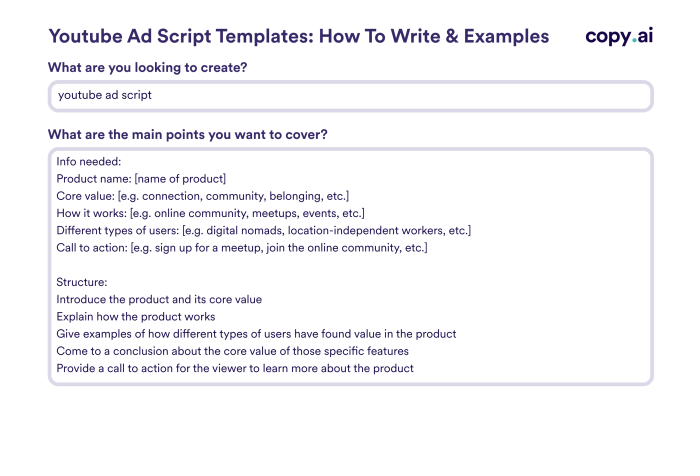Writing Video Scripts for Marketing sets the stage for creating impactful content that resonates with audiences, driving successful campaigns and brand recognition. Dive into the art of scriptwriting and unlock the secrets to engaging storytelling.
Explore the key elements that make video scripts effective and learn how to craft narratives that leave a lasting impression on viewers.
Understanding the Purpose of Video Scripts
Video scripts in marketing are crucial for delivering a clear message to the audience. They help in setting clear objectives and ensuring that the content aligns with the overall marketing goals. By having a well-crafted video script, companies can effectively enhance their brand messaging and storytelling, ultimately leading to increased engagement and conversions.
Importance of Clear Objectives, Writing Video Scripts for Marketing
Having clear objectives in marketing video scripts is essential to ensure that the message is targeted and resonates with the intended audience. By clearly outlining what the video aims to achieve, whether it’s increasing brand awareness, driving sales, or educating customers, businesses can create content that is focused and impactful.
- Example: A company creating a video script to promote a new product launch will have the objective of generating buzz and excitement among customers. The script will be tailored to highlight the key features and benefits of the product, with a call-to-action to encourage viewers to make a purchase.
Aligning with Marketing Goals
Video scripts play a crucial role in aligning with marketing goals by ensuring that the content is in line with the overall marketing strategy. Whether it’s creating brand awareness, increasing website traffic, or improving customer engagement, video scripts can be tailored to meet these specific objectives.
- Example: A company aiming to increase brand awareness can create a video script that tells the story of the brand, its values, and what sets it apart from competitors. By conveying a compelling narrative through the script, the video can effectively resonate with viewers and leave a lasting impression.
Enhancing Brand Messaging and Storytelling
Video scripts are powerful tools for enhancing brand messaging and storytelling. They provide a structured framework for communicating the brand’s message in a cohesive and engaging manner. By carefully crafting the script, businesses can evoke emotions, build connections with the audience, and leave a memorable impact.
- Example: A company with a strong commitment to sustainability can use a video script to showcase its eco-friendly practices, community initiatives, and impact on the environment. By weaving these elements into a compelling narrative, the video can effectively communicate the brand’s values and resonate with environmentally-conscious consumers.
Crafting Compelling Storylines

Creating a captivating storyline in a marketing video script involves several key elements. First, you need to grab the viewer’s attention right from the start with a hook that intrigues them. This could be a problem that needs solving, a relatable scenario, or a surprising fact.
Elements of a Captivating Storyline
- Character Development: Introduce a protagonist that viewers can connect with emotionally. This could be your target audience or a persona representing them.
- Conflict: Every good story needs conflict to keep viewers engaged. This could be a challenge, obstacle, or tension that the protagonist must overcome.
- Resolution: The storyline should lead to a satisfying resolution where the conflict is resolved in a way that resonates with the audience.
- Emotional Appeal: Incorporate emotions like humor, empathy, or excitement to create a lasting impact on viewers.
Tips for Creating a Narrative Arc
- Start with a strong opening that sets the tone for the story and captures attention.
- Build tension throughout the script to keep viewers hooked and eager to see how the story unfolds.
- Include a climax where the conflict reaches its peak, creating a sense of urgency and excitement.
- End with a clear resolution that satisfies viewers and leaves a lasting impression.
Role of Conflict, Resolution, and Emotional Appeal
- Conflict: Conflict adds depth to the storyline and keeps viewers emotionally invested in the outcome.
- Resolution: A satisfying resolution provides closure and leaves a positive impression on viewers.
- Emotional Appeal: Emotions are powerful motivators that can drive action and help viewers connect with your message on a personal level.
Incorporating Call-to-Actions (CTAs): Writing Video Scripts For Marketing

When it comes to marketing video scripts, incorporating Call-to-Actions (CTAs) is crucial for driving viewer engagement and prompting them to take action. CTAs are like signposts that guide your audience on what to do next after watching your video.
Significance of CTAs in Marketing Video Scripts
CTAs help in converting viewers into customers by encouraging them to interact with your brand. They create a sense of urgency and motivate viewers to make a purchase, sign up for a newsletter, visit a website, or engage in any other desired action.
- Example 1: “Click the link below to explore our exclusive collection and get 20% off your first purchase!”
- Example 2: “Subscribe to our channel for more tips and tricks on how to boost your productivity!”
- Example 3: “Don’t miss out on the limited-time offer! Swipe up to shop now!”
Placement Strategies for CTAs within Video Scripts
Strategically placing CTAs within your video scripts is essential to ensure they grab the viewer’s attention and prompt immediate action. Here are some effective placement strategies:
- Place CTAs at the beginning of the video to set the tone and let viewers know what to expect.
- Include CTAs throughout the video to maintain engagement and remind viewers of the action you want them to take.
- End the video with a strong CTA to leave a lasting impression and encourage viewers to act upon the information they just consumed.
Optimizing for Different Platforms
When it comes to tailoring video scripts for various social media platforms, it’s essential to consider the specific characteristics and preferences of each platform. For example, videos on Instagram may need to be shorter and more visually engaging, while YouTube allows for longer, more in-depth content. Adapting video scripts for different target audiences involves understanding their demographics, interests, and preferences.
By customizing the language, tone, and content of the script, you can create a more personalized and impactful message.
Adapting for Different Platforms
- Instagram: Focus on visual storytelling, use concise and attention-grabbing scripts.
- YouTube: Utilize longer scripts for detailed explanations, include timestamps for easy navigation.
- Facebook: Incorporate engaging hooks within the first few seconds to capture audience attention.
Optimizing for
- Include relevant s in the video title, description, and tags to improve searchability.
- Create compelling thumbnails and meta descriptions to increase click-through rates.
- Embed videos on your website and share them across multiple platforms to boost visibility.
